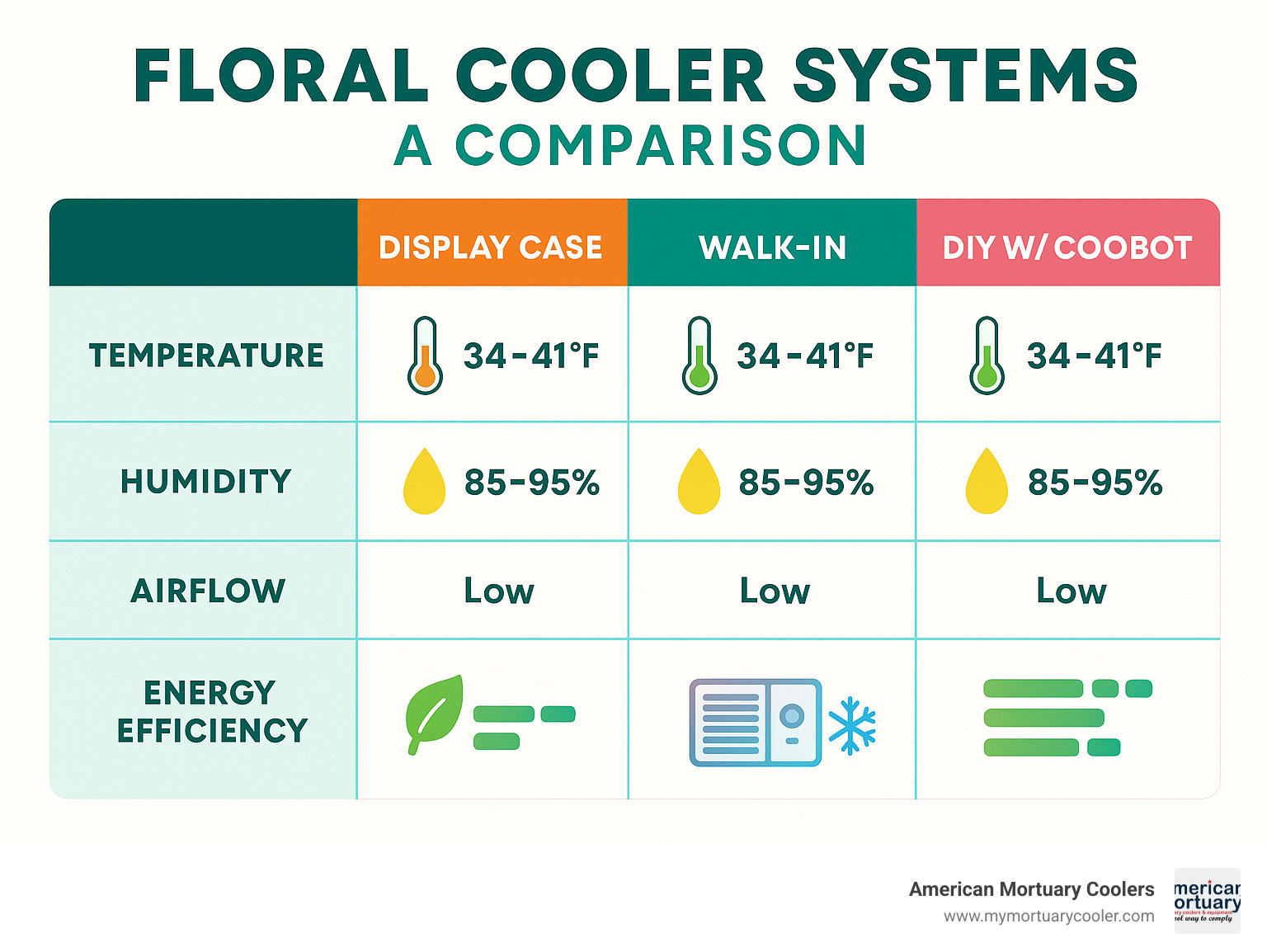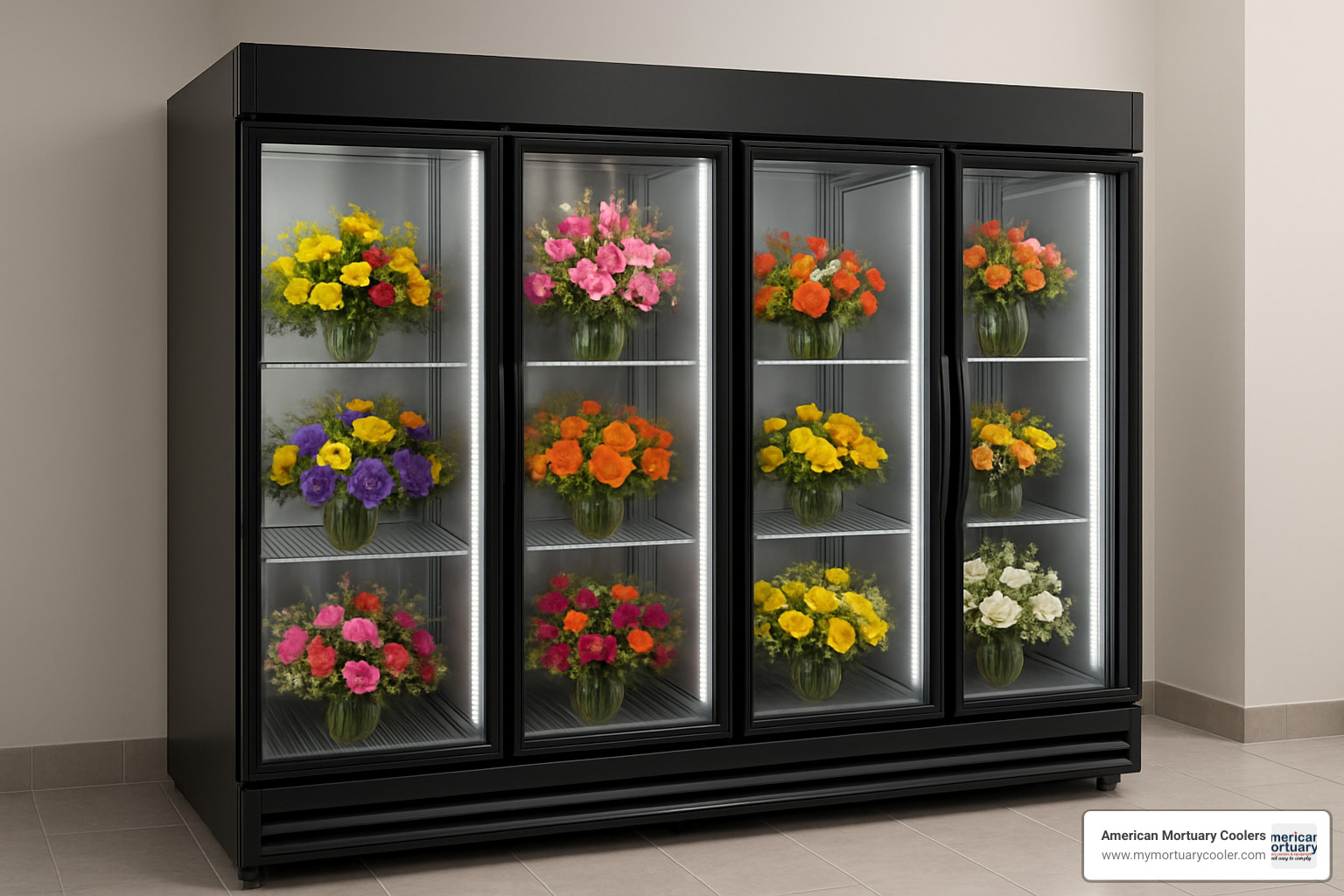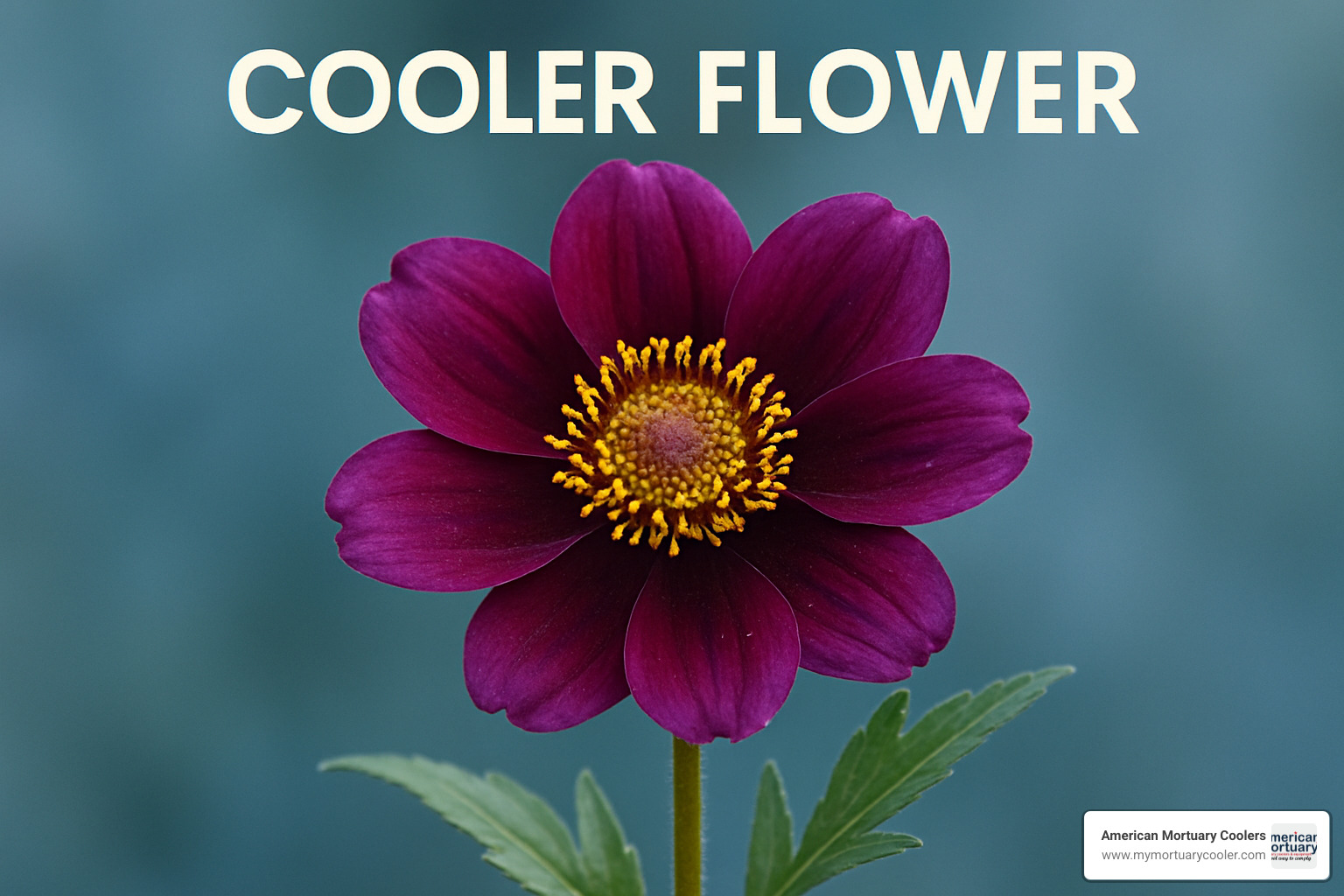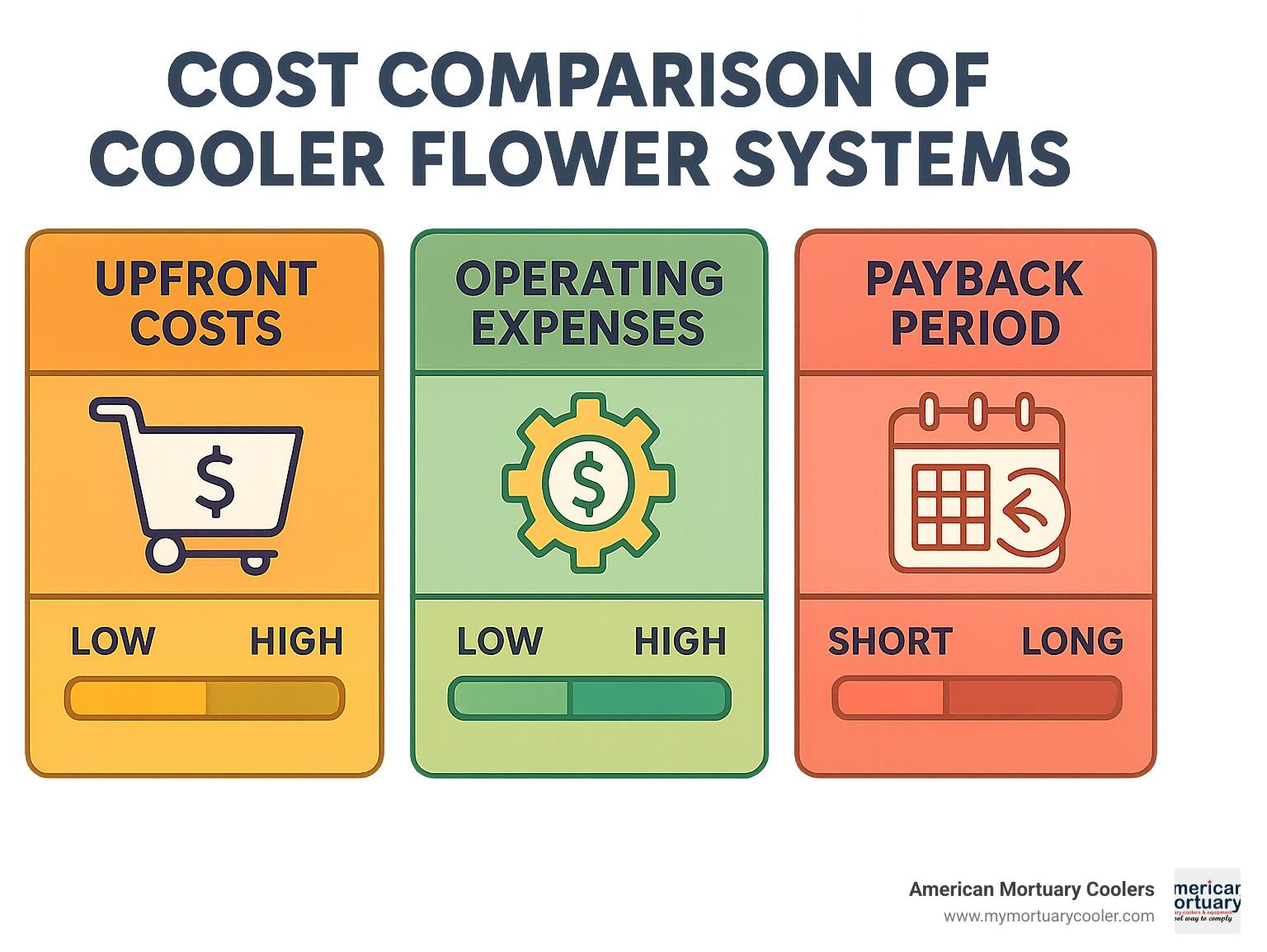Why Proper Floral Storage Makes All the Difference
Cooler flower storage systems are specialized refrigeration units designed to maintain optimal temperature, humidity, and airflow conditions that extend the vase life of cut flowers and floral arrangements. These units differ from standard refrigerators by maintaining higher humidity levels (85-95%) and gentler airflow to prevent flower dehydration.
Key Types of Cooler Flower Systems:
- Display Coolers - Glass-front units for showcasing arrangements (6-71 cu ft)
- Walk-in Coolers - Large storage spaces for bulk inventory and preparation
- DIY Solutions - CoolBot + AC systems that can save 25-50% vs commercial units
Optimal Settings:
- Temperature: 34-41°F (1-4°C)
- Humidity: 85-95% RH
- Airflow: Low velocity to prevent "wind burn"
Whether you're a funeral home director managing memorial arrangements or exploring cost-effective storage solutions, the right cooler flower system can significantly reduce spoilage and extend the beauty of floral displays. Research shows that proper floral refrigeration can double or triple the vase life of cut flowers compared to room temperature storage.
As Mortuary Cooler, I've spent years helping funeral homes nationwide find reliable cooler flower solutions that balance durability with budget constraints. My experience with American mortuary equipment has shown me that the right floral storage system is essential for maintaining the quality and dignity of memorial services.

Simple guide to cooler flower:
Understanding Floral Coolers: Why They Matter
When I first started working with funeral homes across Tennessee, I was amazed by how many directors didn't realize the science behind keeping flowers fresh. It's not just about making things cold - it's about creating the perfect environment where your beautiful arrangements can stay vibrant for days longer.
A proper cooler flower system essentially puts flowers into a gentle sleep, slowing down their natural aging process dramatically. Regular fridges run dry and cold - perfect for your lunch, terrible for flowers. Display coolers and walk-in units designed for flowers maintain humidity levels between 85-95% while keeping temperatures in that sweet spot of 34-41°F.
According to latest research on flower-fridge temperature, getting the temperature just right can literally double how long your arrangements look fresh. For more technical details, you can read more info about floralholdingcoolers.
Temperature & Humidity Science
The 34-41°F temperature band works because it slows down flower respiration without freezing delicate petals. Most flowers do best at the cooler end - around 34-36°F. At these temperatures, flowers use up their stored sugars much more slowly.
Petal hydration is where humidity comes in. Keep the humidity between 85-95%, and those petals stay plump and vibrant. Different flowers have preferences, but consistency matters most - temperature swings stress flowers and shorten their lifespan.
Airflow & Fan-Speed Essentials
You need air circulation, but not too much. Too much airflow creates "wind burn" on delicate petals. Low velocity coils are essential - about 62% gentler than regular commercial coolers. Position vents so they don't blow directly on flowers to prevent stratification and ice-buildup on coils.
7 Quick and Easy Ways to Find the Best Cooler Flower
Shopping for the right cooler flower system can feel like navigating a maze, but it doesn't have to be. After helping hundreds of funeral homes across Tennessee and beyond find their perfect cooling solution, I've learned that the best approach is systematic and focused on your specific needs.
The secret is knowing what questions to ask before you start shopping. Size requirements, energy efficiency, and long-term costs matter more than flashy features you'll never use. Let me walk you through the seven key factors that will help you make a smart decision.
| Feature | Display Cooler | Walk-in Cooler | DIY CoolBot |
|---|---|---|---|
| Size Range | 6-71 cu ft | 100+ cu ft | Custom |
| Initial Cost | $1,000-$7,000 | $8,000-$25,000 | $700-$2,000 |
| Energy Efficiency | Good | Excellent | Very Good |
| Installation | Plug & Play | Professional | DIY Friendly |
| Maintenance | Low | Medium | Low |
First, determine your cooler flower size needs based on your typical volume. A small funeral home might do perfectly with a 20 cubic foot display cooler, while larger operations need walk-in spaces for bulk storage and arrangement preparation.
Second, compare key features that actually matter. LED lighting extends bulb life and reduces heat, while proper door gaskets and glass R-value affect energy costs. Don't get distracted by bells and whistles that won't improve your flower preservation.
Third, calculate energy costs over the unit's lifetime. A cheaper cooler that wastes electricity will cost more in the long run. Look for Energy Star ratings and proper BTU matching to your space requirements.
Fourth, consider aesthetics if the cooler will be visible to families. A beautiful display cooler can actually improve your facility's appearance while serving a practical purpose.
The remaining factors - reading reviews, checking warranties, and understanding installation requirements - separate good purchases from great ones. Take time with each step, and you'll find a cooler flower system that serves your funeral home reliably for years to come.
1. Match Cooler Flower Size to Your Volume
Getting the size right for your cooler flower system is crucial. A small funeral home handling 2-5 services per week typically does well with a 20-40 cubic foot display cooler. This gives you room for about 15-25 standard floral buckets.
Medium-sized operations running 5-10 services weekly usually need 40-70 cubic feet of storage. At this volume, you're storing 30-50 buckets regularly, and you'll appreciate extra room during busy periods.
Seasonal fluctuations can triple your normal storage needs. Wedding season, Mother's Day, and holidays require planning. Calculate your average weekly bucket count, then add at least 20% extra capacity for growth and busy stretches.
Floor space considerations matter more than most realize. Display coolers take minimal room and showcase arrangements beautifully. Walk-in coolers need dedicated space but offer flexibility for larger pieces and arrangement prep work.
Don't forget peak-time bucket-count. Some funeral homes use their busiest week from the previous year as their sizing baseline. Better to have extra space than scramble for storage when you need it most.
2. Compare Key Features Before You Buy
When shopping for a cooler flower system, focus on features that actually matter for flower preservation and energy efficiency.
LED lighting should top your must-have list. Quality LED systems slash energy bills by 75% compared to fluorescent bulbs and show off arrangements with better color accuracy. Look for adjustable brightness controls.
Glass door insulation is often overlooked. Standard insulated glass has only R-1.8 value while efficient cooler walls have R-25 insulation. Your glass display window becomes a giant energy leak, forcing your refrigeration system to work twice as hard.
Door gaskets create airtight seals that keep conditioned air inside. Poor gaskets can increase energy bills by 25% or more. Look for magnetic gaskets that are easy to clean and replace.
Temperature alarms are insurance against disaster. Modern monitoring systems ping your smartphone when temperatures drift outside safe zones. Getting woken up at 2 AM beats walking into spoiled flowers on service morning.
For more detailed insights on choosing features for your needs, check out more info about floristcooler.
Don't let salespeople talk you into unnecessary bells and whistles, but don't skimp on features that actually matter for flower preservation and energy efficiency.
3. Calculate Energy & Lifetime Cost Savings
The sticker price of a cooler flower system is often less than half of what you'll actually spend over its lifetime. Energy costs, maintenance, and potential flower loss add up quickly without smart choices.
Modern floral cooling systems with proper R-25 insulation and smart controllers can slash energy bills by 40% compared to older models. One director in Georgia told us his new system paid for itself in 18 months through energy savings alone.
CoolBot systems deserve special mention, reducing energy consumption by about 40% compared to traditional coolers while maintaining precise temperature control. Smart controllers learn your usage patterns and adjust cooling cycles accordingly.
When crunching numbers, factor in potential product loss. A cooler failure during a busy weekend can cost thousands in spoiled arrangements. Energy Star rated units offer better reliability along with energy savings.
The math typically works out like this: a more expensive unit with better insulation and smart controls pays for itself within 18-24 months through energy savings alone. After that, you're saving money every month while enjoying better temperature control.
4. Read Reviews & Ask for Real-World Testimonials
Real-world performance often differs from manufacturer specifications. We always recommend speaking with other funeral homes about their experiences with specific cooler flower systems.
Look for testimonials that mention performance during peak periods like wedding season. A cooler that works fine with light loads might struggle when fully loaded with arrangements for multiple services.
Pay attention to comments about quick pull-down times - how fast the unit recovers to proper temperature after door openings. This is crucial during busy periods when staff are frequently accessing stored arrangements.
Ask about reliability during extreme weather. Summer heat puts extra stress on refrigeration systems, and you need a unit that maintains proper temperature even during heat waves.

DIY Cooler Flower with CoolBot: Step-by-Step Guide
Building your own cooler flower system is one of the smartest moves a budget-conscious funeral home can make. A CoolBot controller paired with a standard 12,000 BTU air conditioner delivers professional-grade performance for $700-$2,000 total investment versus $8,000-$25,000 for manufactured walk-in coolers.
The CoolBot tricks your AC unit into cooling down to 30°F instead of its usual 65°F cutoff, maintaining a steady 39°F even during busy periods. The scientific research on CoolBot efficiency backs up real-world results. For comprehensive construction guidance, check out these DIY tips.
Materials Checklist & Budget
Your CoolBot controller ($300-400) serves as the system brain. Pair it with a reliable 12,000-15,000 BTU window AC unit ($400-600). Don't go smaller - you need extra capacity for quick recovery after door openings.
Insulation is critical. You need rigid foam panels with at least R-10 value, though R-15 is better. Budget $200-400 for proper materials. Add sealants, vapor barriers, and door hardware ($150-300), plus optional Wi-Fi monitoring ($100-200) and LED lighting ($50-150).
Total investment typically falls between $700-$2,000 depending on size and features - that's 25-50% less than manufactured alternatives.
Build & Wiring Steps
Mount your AC unit high at eye level for proper airflow distribution without creating direct drafts on arrangements. The CoolBot sensors need precise positioning - one attaches to your AC's existing sensor, another monitors room temperature.
Professional wiring is worth the investment for safety and reliability. Seal gaps with spray foam insulation - even tiny air leaks dramatically impact performance. Test everything thoroughly before loading arrangements.
Add Remote Monitoring & Automation
Phone alerts for temperatures above 45°F or below 32°F provide peace of mind, preventing costly flower loss and allowing quick response to equipment issues. Some systems integrate with building automation for centralized monitoring of multiple coolers.
Best Practices for Organizing, Displaying & Maintaining Floral Coolers
The difference between a cooler flower system that serves you well versus one that becomes a headache often comes down to organization and maintenance. Well-managed units extend freshness by 2-3 days compared to poorly organized coolers.
Wire shelving allows air to circulate freely around arrangements. Solid shelves create dead air pockets leading to temperature variations. Position shelves with at least 6 inches clearance from walls and ceiling for proper air circulation.
Food-grade buckets are non-negotiable for cut flower storage. Regular containers can leach chemicals that harm flowers. Clean buckets weekly and check coil cleanliness monthly. For specialized guidance, check out more info about Funeral Flower Supplies.

Shelving, Buckets & Humidity Hacks
Tiered rack systems maximize storage while maintaining airflow. Place delicate arrangements on upper shelves, away from door traffic and temperature fluctuations. Save lower levels for hardier flowers like chrysanthemums.
Water-line marks on buckets ensure consistent hydration. Change water every 2-3 days and clean buckets weekly with diluted bleach solution to prevent bacterial buildup that shortens flower life.
Protecting Doors & Components for Longevity
Door hinges and gaskets take constant abuse. Replace gaskets immediately when worn - a torn gasket increases energy consumption by 25% and creates temperature fluctuations. Check hinge alignment regularly for smooth operation and proper sealing.
Lubricate hinges quarterly with food-grade lubricant. For detailed maintenance guidance, visit more info about walk-in door care.
Ethylene & Disease Management
Ethylene gas accelerates flower aging. Proper ventilation through normal door openings usually provides adequate control. Floralife packets contain ethylene inhibitors that extend flower life - follow instructions carefully.
Sanitizer fogging systems control bacterial and fungal growth. Schedule weekly treatments during peak periods, maintaining consistency for effective protection.
Costs, Warranty, Financing & Support Overview
The sticker price on a cooler flower system is just the beginning. Energy-efficient models that cost 20-30% more upfront typically save funeral homes 40% on energy bills monthly. Quality systems pay for themselves through energy savings and reduced flower loss within 18-24 months.
Most manufacturers offer financing plans spreading payments over 3-5 years, making monthly costs more manageable. For detailed warranty information on DIY options, check out more info about CoolBot warranties.

Upfront vs Monthly Savings Breakdown
Small display units start around $1,000, but walk-in systems can hit $25,000. However, operating expenses over 10-15 years often dwarf initial investment. Quality insulation and smart controls typically save $300-500 annually in energy costs with payback periods of 18 months or less.
Warranty & Service Must-Haves
Focus on comprehensive parts and labor coverage for at least 3 years. Critical failure points are compressors, controllers, and door systems. Quality manufacturers offer solid warranty coverage and nationwide service networks. Some now provide remote diagnostics for 24/7 monitoring.
Monitoring & Control Options
Bluetooth temperature probes connect to smartphone apps for remote monitoring. Cloud-based dashboards track trends over time, helping identify maintenance needs before equipment fails. For larger operations, integration with building management systems allows centralized control of multiple coolers.
Frequently Asked Questions about Cooler Flowers
How cold should a cooler flower stay?
The sweet spot for most cut flowers is 34-36°F. This temperature range slows down flower respiration, preserving beauty much longer. Delicate orchids prefer 38-40°F, while sturdy chrysanthemums handle cooler temperatures fine. Consistency beats perfection - steady 36°F outperforms fluctuating temperatures even within the correct range.
Can I use a humidifier inside?
No, don't add a humidifier to your cooler flower system. Your floral cooler already maintains 85-95% humidity, which is exactly what flowers need. Adding more moisture creates breeding grounds for bacteria and mold. Control humidity by properly sizing your cooling system so it doesn't run constantly.
What causes foul odors or mold?
Poor air circulation, dirty buckets, and neglected maintenance cause odors and mold. Bacteria love stagnant air and standing water. Clean buckets weekly with diluted bleach solution, change flower water every 2-3 days, and remove wilted blooms immediately. For persistent issues, consider sanitizer fogging treatments during off-hours.
Conclusion & Next Steps
Finding the perfect cooler flower system doesn't have to feel overwhelming. There's no one-size-fits-all solution - match your system to your actual needs, considering your busiest weeks, available space, and maintenance capabilities.
At American Mortuary Coolers, we've spent years helping funeral homes across Tennessee and the entire country steer these decisions. We focus on durability and custom solutions that fit your exact situation, with Tennessee-based manufacturing and direct delivery across all 48 contiguous states.
The investment in quality cooler flower storage pays for itself quickly through reduced spoilage, extended freshness, and reliable equipment. During emotional moments when families are saying goodbye, you need confidence that your flowers will stay beautiful.
Ready to take the next step? Start by measuring your current floral volume during busy periods, count typical arrangements stored, note available floor space, and consider growth plans. This information helps us recommend the most cost-effective solution.
For comprehensive information about our complete range of mortuary solutions, visit more info about morgue freezer solutions. Our team is ready to discuss your specific needs and design a system that ensures every memorial service maintains the dignity and beauty your families deserve.
















